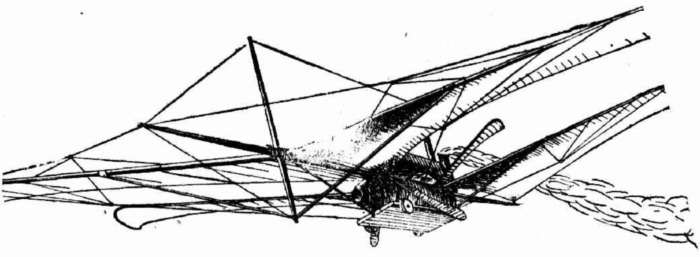In May 1911, two policemen were sent out from Yamba, a logging town at the mouth of the Clarence River in northern New South Wales, to investigate something odd which had been found on 'top of a sandhill near Ryan's waterhole, about six miles [away] and about 400 yards in from the beach':
a rudely-constructed aeroplane, 30 feet in length and 4 feet wide, with a wing on one side about 2 feet wide. Extending the full length in the middle was a sort of platform with a seat roughly fixed with fencing wire and padded with old bagging. Scores of fine wires were fixed to the platform and extending to all parts of the structure. There were two keels braced together with split bamboo rods, every six inches, like the timbers in a boat. Every joint was securely and neatly capped with fine wire. Only two nails were used in the whole construction [...] The most peculiar thing about the craft was
that it could be plainly seen that the only tool used in preparing the timber had been a knife [...] The whole floor of the structure was covered with newspapers pasted together, forming a very thick pad.1
None of the newspapers was dated later than 3 May 1911, and the aeroplane 'appeared to have been only a short period of time at the spot where it was discovered, as the papers were quite fresh and not discoloured'.2 Another odd detail was
that from low water mark on the beach near the sea is a deep and narrow track from the water's edge up the steep sandhill to where the airship was lying, appearing as if something from the sea had been dragged up to the spot where the structure was lying.3
One report suggested that 'the plane had evidently been damaged, since one of the flaps had been damaged', though here 'plane' should be taken to mean 'wing' rather than 'aeroplane'.4 Since 'There is no trace of any engine about', it was surmised that the machine was a glider:
The builder had evidently taken an aeroplane for a model, and attempted to construct a single plane, which would allow him to float with tbe wind from the top of one of the sand hills of the Terrace.3
But who was this mysterious builder? Suspicion quickly fell on 'an elderly man [...] a stranger to Yamba, who bought stores and papers a few times from local people' and who 'has since disappeared'.3 Within a few days of the initial story, it was being regarded locally as 'a hoax'.5 That can't be ruled out, though the possible motivation (other than sheer perversity) of leaving a fake aeroplane for somebody to stumble across is unclear.
...continue reading







